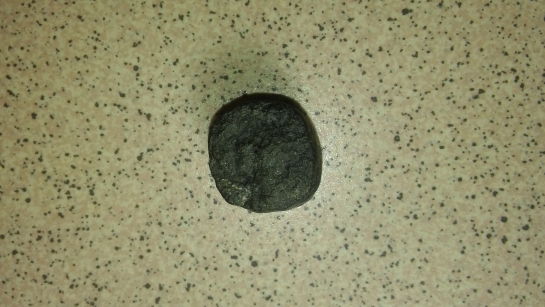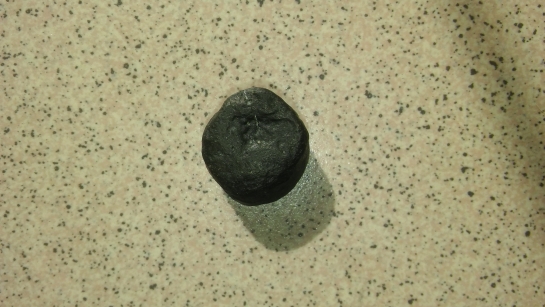Fish vertebrae?
- Colin Ashcroft
- Berichten: 31
- Lid geworden op: 16 jun 2012, 15:09
- Contacteer:
Fish vertebrae?


Hi all!
I went searching the beach last week along the beach at Cadzand. I found a small item (see attached photograph) and thought it might be a fish vertebrae fossil. Can anyone confirm it is or isn't? I'm not sure having never found one before!
Thank you for your help.
Cheers,
Colin.
- FossilDude
- Administrator
- Berichten: 2368
- Lid geworden op: 24 nov 2007, 22:23
- Locatie: Leuven, België
- Has thanked: 327 times
- Been thanked: 310 times
- Contacteer:
Antw: Fish vertebrae?
Hi Colin,
The item in your photographs is indeed a Neogene fossil of a fish, but not of a vertebrae. It is the fossil base of a spine of a skate, more precisely of the Thornback ray ( Raja clavata )
See comparable examples in our database:
http://www.fossiel.net/id_system/fossil ... tformatie=
Cheers,
Johan
[Bewerkt door FossilDude op 04-09-2015 om 12:10 NL]
The item in your photographs is indeed a Neogene fossil of a fish, but not of a vertebrae. It is the fossil base of a spine of a skate, more precisely of the Thornback ray ( Raja clavata )
See comparable examples in our database:
http://www.fossiel.net/id_system/fossil ... tformatie=
Cheers,
Johan
[Bewerkt door FossilDude op 04-09-2015 om 12:10 NL]
Van je hobby je beroep maken.... kan het nog beter? ;)
- Colin Ashcroft
- Berichten: 31
- Lid geworden op: 16 jun 2012, 15:09
- Contacteer:
Antw: Fish vertebrae?
Hi Johan,
thanks a lot for the detailed and quick response! That's really fascinating! I was looking for Shark teeth but found this instead. Really happy I found it! I'm familiar with the modern day Thornback ray, completes the story! One question, a ray has cartilage instead of true bone. Does this mean that the fossilisation process had to be very quick to preserve this?
Thanks very much for the info and link.
Cheers, Colin.
thanks a lot for the detailed and quick response! That's really fascinating! I was looking for Shark teeth but found this instead. Really happy I found it! I'm familiar with the modern day Thornback ray, completes the story! One question, a ray has cartilage instead of true bone. Does this mean that the fossilisation process had to be very quick to preserve this?
Thanks very much for the info and link.
Cheers, Colin.
- FossilDude
- Administrator
- Berichten: 2368
- Lid geworden op: 24 nov 2007, 22:23
- Locatie: Leuven, België
- Has thanked: 327 times
- Been thanked: 310 times
- Contacteer:
Antw: Fish vertebrae?
Hi Colin,
Actually, I've made a translation mistake in my response. Unfortunately, I misused the word 'spine'!
Your fossil is not a part of the spinal chord (vertabrae). I actually mean that it is the base of a thorn. The Thornback ray has a series of large thorns on its back (hence the name). These thorns are actually large (placoid) scales. In contrast to their spinal chord, the scales of rays and sharks are not from cartilage, but from the same material as there teeth (the placoid scales are also known as 'dermal denticles'.
Cheers,
Johan
[Edited by FossilDude on 04-09-2015 at 12:52 GMT +1]
Actually, I've made a translation mistake in my response. Unfortunately, I misused the word 'spine'!
Your fossil is not a part of the spinal chord (vertabrae). I actually mean that it is the base of a thorn. The Thornback ray has a series of large thorns on its back (hence the name). These thorns are actually large (placoid) scales. In contrast to their spinal chord, the scales of rays and sharks are not from cartilage, but from the same material as there teeth (the placoid scales are also known as 'dermal denticles'.
Cheers,
Johan
[Edited by FossilDude on 04-09-2015 at 12:52 GMT +1]
Van je hobby je beroep maken.... kan het nog beter? ;)
- Colin Ashcroft
- Berichten: 31
- Lid geworden op: 16 jun 2012, 15:09
- Contacteer:
Antw: Fish vertebrae?
Hi Johan,
that's no problem. Even more fascinating to me that it comes from the base of a thorn. I have actually worked with Thornback rays in the past and I know exactly what you are talking about! A species you could feel many denticles scratch your hand if rubbed the wrong way is the Dogfish, a member of the shark family.
I wonder if there is a way of working out the size of the ray which my thorn came from? I measured the diameter to be approx 1.8 - 2.0 cm. I suppose there would be too many variables.
Thanks again for your expertise and time!
I'm going to post a couple more items. They might really be nothing but we can see!
Take care,
Colin.
that's no problem. Even more fascinating to me that it comes from the base of a thorn. I have actually worked with Thornback rays in the past and I know exactly what you are talking about! A species you could feel many denticles scratch your hand if rubbed the wrong way is the Dogfish, a member of the shark family.
I wonder if there is a way of working out the size of the ray which my thorn came from? I measured the diameter to be approx 1.8 - 2.0 cm. I suppose there would be too many variables.
Thanks again for your expertise and time!
I'm going to post a couple more items. They might really be nothing but we can see!
Take care,
Colin.